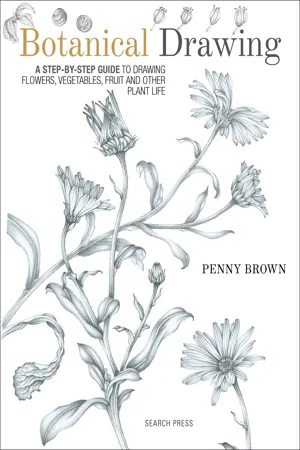
eBook - ePub
Botanical Drawing
A Step-By-Step Guide to Drawing Flowers, Vegetables, Fruit and Other Plant Life
- 144 pages
- English
- ePUB (mobile friendly)
- Available on iOS & Android
eBook - ePub
Botanical Drawing
A Step-By-Step Guide to Drawing Flowers, Vegetables, Fruit and Other Plant Life
About this book
The definitive artist's guide to drawing detailed and accurate plants, flowers and other vegetation in pencil—including illustrations and exercises.
Botanical Drawing provides a thorough and expert guide to the subject, touching on the history of this fascinating art form as well as its rules and practicalities. Artist Penny Brown explains the materials, learnings and techniques required to produce accurate botanical illustrations. She also includes an accessible, basic study of botany for the absolute beginner.
By following Brown's step-by-step instructions, close studies and explorations of the subjects, you will be able to produce your own illustrations of plants, flowers, vegetables and their myriad parts. Botanical Drawing offers knowledge, techniques, and inspiration as you create your own projects.
Botanical Drawing provides a thorough and expert guide to the subject, touching on the history of this fascinating art form as well as its rules and practicalities. Artist Penny Brown explains the materials, learnings and techniques required to produce accurate botanical illustrations. She also includes an accessible, basic study of botany for the absolute beginner.
By following Brown's step-by-step instructions, close studies and explorations of the subjects, you will be able to produce your own illustrations of plants, flowers, vegetables and their myriad parts. Botanical Drawing offers knowledge, techniques, and inspiration as you create your own projects.
Frequently asked questions
Yes, you can cancel anytime from the Subscription tab in your account settings on the Perlego website. Your subscription will stay active until the end of your current billing period. Learn how to cancel your subscription.
No, books cannot be downloaded as external files, such as PDFs, for use outside of Perlego. However, you can download books within the Perlego app for offline reading on mobile or tablet. Learn more here.
Perlego offers two plans: Essential and Complete
- Essential is ideal for learners and professionals who enjoy exploring a wide range of subjects. Access the Essential Library with 800,000+ trusted titles and best-sellers across business, personal growth, and the humanities. Includes unlimited reading time and Standard Read Aloud voice.
- Complete: Perfect for advanced learners and researchers needing full, unrestricted access. Unlock 1.4M+ books across hundreds of subjects, including academic and specialized titles. The Complete Plan also includes advanced features like Premium Read Aloud and Research Assistant.
We are an online textbook subscription service, where you can get access to an entire online library for less than the price of a single book per month. With over 1 million books across 1000+ topics, we’ve got you covered! Learn more here.
Look out for the read-aloud symbol on your next book to see if you can listen to it. The read-aloud tool reads text aloud for you, highlighting the text as it is being read. You can pause it, speed it up and slow it down. Learn more here.
Yes! You can use the Perlego app on both iOS or Android devices to read anytime, anywhere — even offline. Perfect for commutes or when you’re on the go.
Please note we cannot support devices running on iOS 13 and Android 7 or earlier. Learn more about using the app.
Please note we cannot support devices running on iOS 13 and Android 7 or earlier. Learn more about using the app.
Yes, you can access Botanical Drawing by Penny Brown in PDF and/or ePUB format, as well as other popular books in Art & Art General. We have over one million books available in our catalogue for you to explore.
Information
COMPOSITION
The layout or composition of your drawing needs as much careful consideration as the tone or botanical accuracy does. A poorly-composed drawing will lack impact and will not capture the viewer’s attention. Your drawing needs to have balance and harmony but also contrast and rhythm. The viewer’s eye should be drawn into your picture and then guided around it.
Follow these guidelines to create pleasing compositions:
•Try not to have lines that take the viewer’s eye out of the picture or designs that leave the centre empty with all the interest dotted around the edge.
•Look at the spaces between your objects; these negative spaces need to balance too.
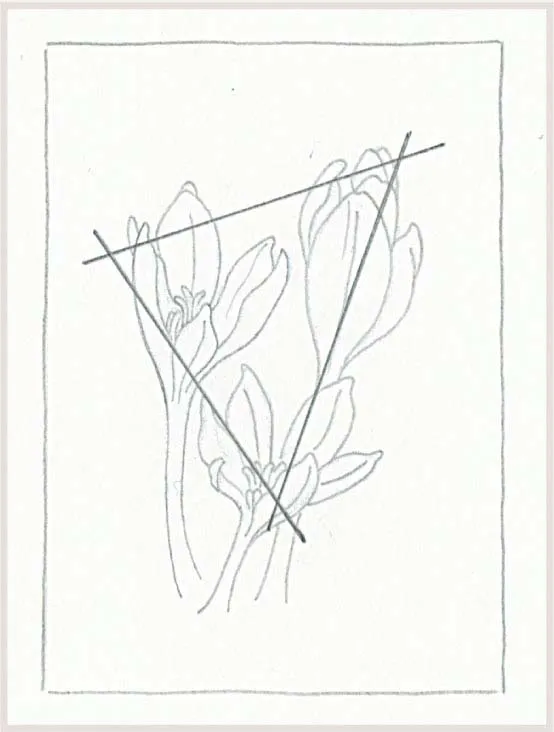
Autumn crocus
This sketch demonstrates very simply the power of odd numbers in creating a harmonious composition. The three crocus flowers are arranged in a triangle. Within this formality, the differing angles of the flowers create interest.

Asparagus
I wanted to avoid drawing a traditional picture of a bunch of asparagus tied with raffia. I arranged the stems, laying the cut stem horizontally at the base to give weight. I felt that the stems, just by themselves, looked disconnected and severe, so I drew a piece of dried asparagus fern in the background. I felt it linked together the other elements in the picture and added a soft, flowing line to the composition.
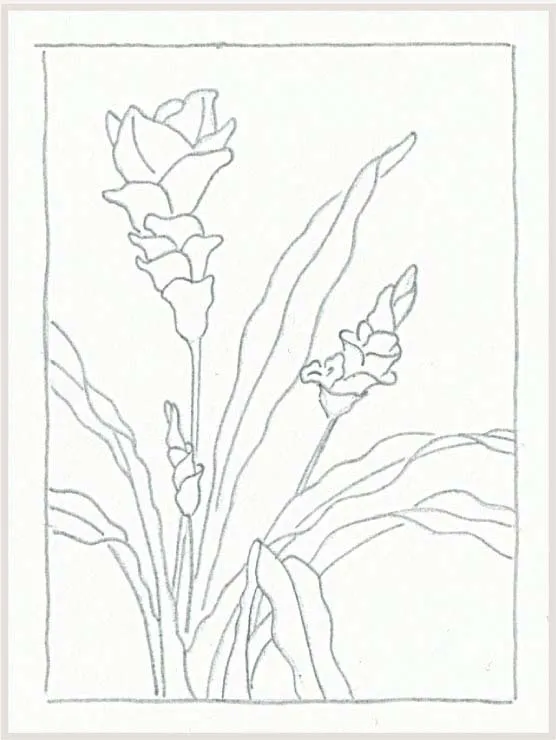
Siam tulip
This plant formed its own sculptural, dramatic composition. I placed the largest flower off-centre and allowed the large leaves to explode out of the page. This is a strong, architectural arrangement, where the plant appears to grow out of the base of the picture. The freesia project on pages 112-119 has a similar simple, almost stark composition.
•Avoid overcluttering your work; give your subject breathing space. You could try drawing some areas more softly, perhaps lessening the focus of areas that are in the background. This allows the eye to rest, and shifts the focus to the important parts of the composition.
•Hold your work up to a mirror: when you see it ‘the wrong way round’ you will gain a different viewpoint, which can make it easier to spot elements that are not working. I sometimes take a photograph of a work in progress as I find the effect of seeing the drawing ‘flattened’ on screen can be helpful in pointing out any deficiencies.
Across these two pages are examples of compositions which illustrate different styles, layouts and arrangements to show how varied botanical drawings can be.
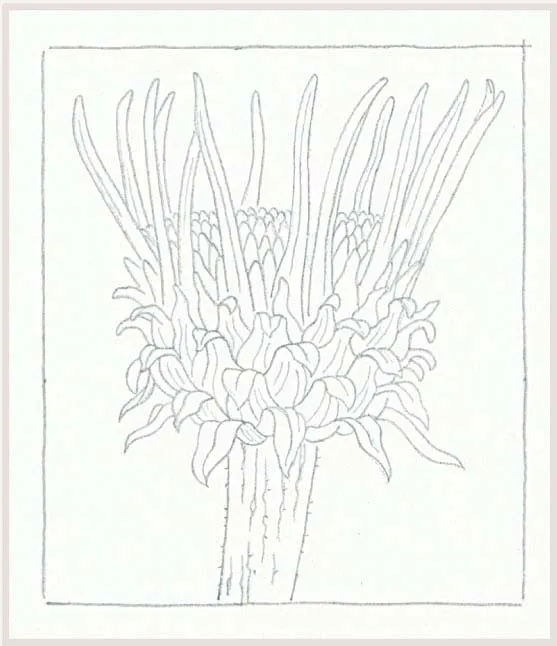
Echinacea bud
Enlarging the subject, sometimes by a great deal, can be exciting to the botanical artist. Draw the subject in isolation in the centre of the page or crop it severely in half. These type of drawings can be almost dizzying in their level of detail, and are made more achievable by the clarity of images from a digital camera or a microscope. The finished drawing of this echinacea bud can be seen on page 2; the Brussels sprout on page 59 is another example.
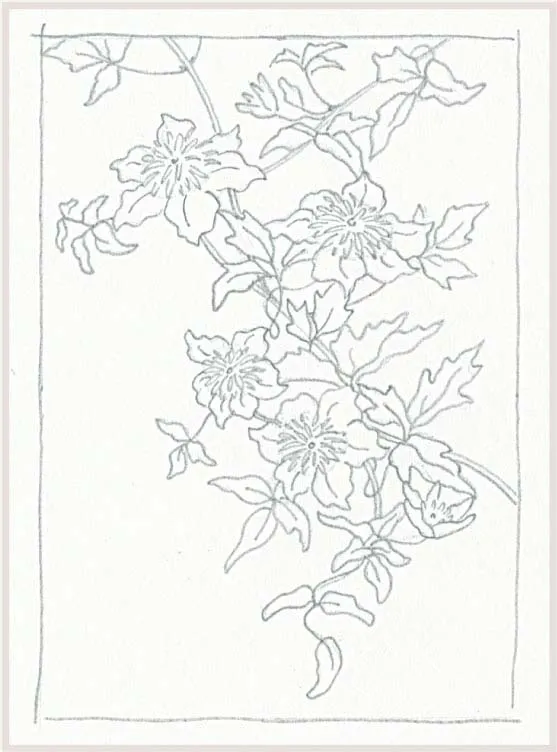
Clematis florida ‘Sieboldii’
This composition, where the climbing plant tumbles down from the top of the page in an energetic diagonal, captures its growth habit. The leaves and stalks extend out of the frame and hint at the rest of the plant, while the tangle and coils of the stems illustrate that the plant is a climber.

Autumn berries
A study page – a composition of small objects – needs much thought and careful placing. The shapes and tones need to be balanced to add variety, visual interest and delicacy. The seaweed study on page 143 is another example of this style of composition. Sometimes I position small objects in different patterns, in spirals, circles or in a sweeping curve across the page. See the nut spiral on page 69 and the Cape gooseberry project on pages 98–101.
INSPIRATION
A good way to learn about composition is to look closely at other artists’ work. Analyse the structure. How do the various elements in the picture balance each other? How do the lines draw the eye into and around the design? If you don’t like a particular painting, analyse why this might be. Study the works of great artists – not necessarily restricting yourself to botanical artists – and let them inspire your work.
The next two sketches show how the composition of a renowned artist’s work inspired one of my own paintings.

A sketch of The Wave (1760–1849)
The original, beautifully composed painting has great vigour. The wave crest to the left fills that side of the picture with energy and then dips in the centre, only to rise up again on the right.
BUILDING UP A COMPOSITION
Some compositions will come together easily; others require trial and error and preliminary sketches. Sometimes I will draw the separate elements on individual sheets of tracing paper, layering them up in different configurations until they look right. Other times I will work out the layout in thumbnail sketches, which is a good, quick way to work. More troublesome compositions may need redrawing: sometimes I will trace or photocopy the compositions, cut out some elements and paste them down in new arrangements.
The sketches on the right show three stages in planning the composition of a drawing of parrot tulips. Notice how the elements have been rearranged until a satisfying composition is achieved.
I thought I would use the sha...
Table of contents
- Cover
- About the Author
- Dedication
- Title
- Acknowledgments
- Copyright
- Contents
- INTRODUCTION
- Botanical art: a personal perspective
- Materials and tools
- Getting started
- Understanding plant structure
- Botanical illustrations
- Gathering information
- Composition
- Backcover